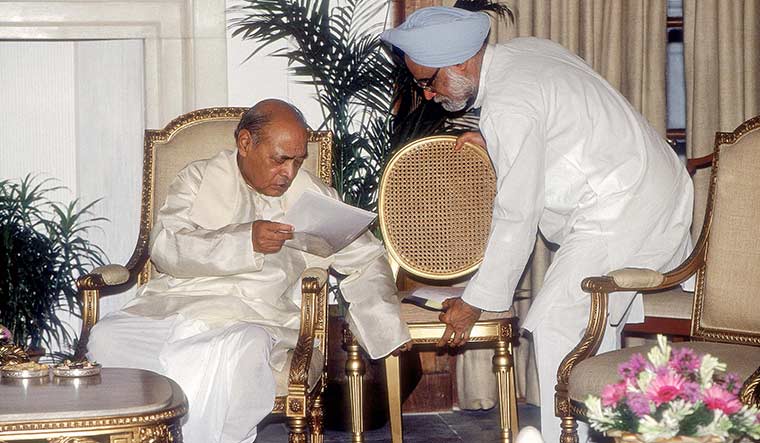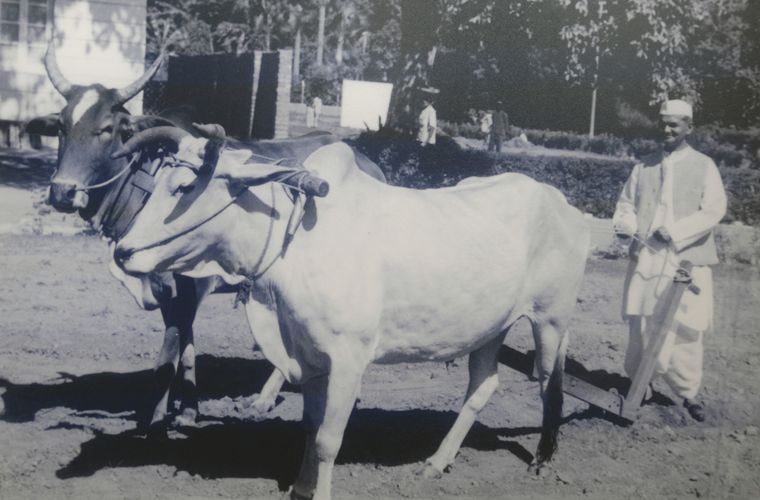On November 26, 1947 independent India's first finance minister R.K. Shanmukham Chetty, a non-Congressman handpicked by Prime Minister Jawaharlal Nehru, presented the maiden budget with a promise to spend Rs197.39 crore. A large chunk of it was devoted to ensuring food security and the rehabilitation of partition refugees. While Chetty was assured of revenue of about Rs171 crore, the 2022-23 budget presented by Finance Minister Nirmala Sitharaman proposed to spend Rs39,44,909 crore, about 20,000 times more.
India in 1947 was left socially and financially battered by the British. In 2022, its economy surpassed that of its erstwhile colonial masters to became the fifth largest in the world. This journey is also the story of how some crises prompted successive prime ministers to look for solutions that led to epochal economic changes in the country.
Prime Minister Narendra Modi made a few bold reform moves, particularly during the pandemic, giving the economy a direction—Atmanirbhar Bharat initiatives to make India a manufacturing hub, the increased digitisation of financial instruments, direct beneficiary transfer scheme, GST, the insolvency and bankruptcy code.
It was also a difficult situation—the balance of payment crisis in 1991—that forced prime minster P.V. Narasimha Rao to make a break from the past with the help of finance minister Manmohan Singh. In fact, Nehru himself was prompted to choose a direction by a humanitarian crisis that threatened the fledgling nation.
The policy that guided India for 44 years out its 75 years of independence came out at the 1955 Avadi session of the Congress, where Nehru laid the ideological foundation of his party and the economic road map for the government: a socialistic pattern of society. The Congress formally adopted it, along with the decision to formulate five-year plans. In his speech, Nehru explained the need for five-year plans. “Our people consume sugar more than they used to, with the result our calculations about sugar production went wrong. Earlier they earned Rs100; if now they earn Rs150 they will eat more sugar and buy more cloth,” he said, drilling into the minds of the Congressmen what he intend to do with the economy. The Planning Commission grew in strength as it formulated the needs and the development path for the nation.
Seventy years later—a phrase which has become a leitmotif for the break from the past—Modi, who was always at loggerheads with the Planning Commission as Gujarat chief minister, decided to discontinue it and shut down Yojna Bhawan. But he created a new one: NITI Aayog.
In 44 years before the 1991 reforms, the economy did not deviate from much from Nehru’s roadmap. He argued that India must produce wealth, and then divide equitably. “How can we be a welfare state without wealth. Our economic policy must aim at plenty,” he said. For this, he focused on public sector and heavy industry with the help of statistician P.C. Mahalanobis.
The Nehru-Mahalanobis plan faced opposition from the Bombay Club, an informal group of industrialists, and pro-private enterprise leaders like C. Rajagopalachari and Minoo Masani. But they could not push much in the political atmosphere at that time. The socialist pattern of development attracted much criticism for bureaucratisation, as the license-permit-quota raj was clearly hindering India's economic progress.
One major policy intervention with far-reaching consequences was initiated by Lal Bahadur Shastri. Looking for ways to address the food crisis, he initiated the Green Revolution, which created a whole new dynamics as agriculture-dominated states prospered.
Indira Gandhi's government was beset with political and economic crises. The grain harvest had shrunk and inflation sky-rocketed. In a few months into her tenure, she took everyone, including her partymen, by surprise by devaluing the rupee from Rs4.76 a dollar to Rs7.5 on June 6, 1966 in a late-night broadcast. She was accused of selling the country out to the US and the World Bank.
However, Indira soon went a step ahead of her father’s socialist model by nationalising 14 private banks that controlled 85 per cent of total deposits. This was followed by nationalisation of insurance companies, coal mines, and sugar and textile mills. In her second term, though, she tried to ease controls in industrial licensing. The reformist mindset was termed as a rightward shift. Rolling out Maruti during her tenure remains a success story of all times. As India had suffered the humiliation of wheat aid to feed its millions of mouths, she focused on pushing Green Revolution.
Indira’s assassination pushed India into a political crisis, but Rajiv Gandhi, the youngest prime minister ever, made concrete attempts to improve the economy by bringing in the telecom revolution and logging into computers. He brought in businessmen to lead public enterprises.
However, the real break came in 1991 after the balance of payment crisis when India had to pledge a portion of its gold reserve to foreign banks. The Chandra Shekhar government could not even get its budget passed in Parliament. The minority government that followed it, led by Narasimha Rao, undertook the biggest reforms in independent India. “No power on earth can stop an idea whose time has come... India as a major economic power in the world happens to be one such idea. Let the whole word hear it aloud and clear India is now awake. We shall prevail. We shall overcome,” said Manmohan Singh in his 18,425-word budget speech.
Ironically, the Bombay Club, which opposed Nehru for playing socialist, opposed the 1991 reforms as well, saying Indian companies will be at a disadvantage with the entry of the foreign players.
Atal Bihari Vajpayee's government continued with the reforms. He privatised many state-owned companies and gave the much-needed push to highway building. But he misread the pulse of the public, lost the elections and Manmohan Singh rose to the top chair. Owing to the pressures of coalition and with the left parties breathing down his neck, Singh shifted his focus to the social sector, launching schemes like NREGA. He stayed the course and steered the economy during the difficult years of the 2008 slowdown.
Manmohan's second term, however, was marred by allegations of corruption and policy paralysis, and Narendra Modi entered the scene with a bang. Many of Modi’s reforms met with opposition, but he pushed through them with the sheer power of his political persona. His 8pm announcement on demonetisation on November 8, 2016 took the country by surprise. Though it failed to achieve the desired goal, it did nudge the country towards digital payments. In fact, many of Modi’s policy decisions have been to nudge people towards a behavioural change.
Modi’s aim has been to leave a mark on all the fronts and signal a shift from the past—replacing the Planning Commission with NITI Aayog, doing away with the railway budget, and relaxing foreign investment norms. The Insolvency and Bankruptcy Code, improved ease of doing business, goods and services tax are sold as the high points of his tenure. Also, there has been a push towards making startups a new business model to generate employment and boost growth.
But the more things changed, the more they remained the same. Policy analyst Sanjaya Baru, who was Manmohan Singh's media adviser, said the 2022 budget speech of Finance Minister Nirmala Sitharaman tapped into the Nehruvian strategy of public investment-led growth in industrial sector. Capital investment holds key to speedy and sustained economic revival. “We once again hear echoes of Bombay Plan, Mahalanobis plan and mixed economy model of public private partnership,” he said.



